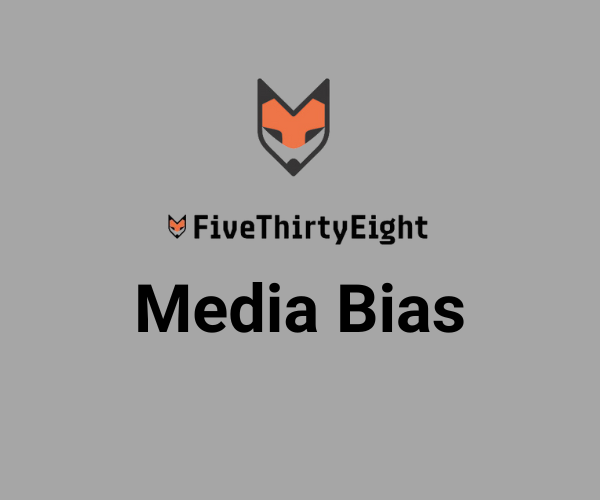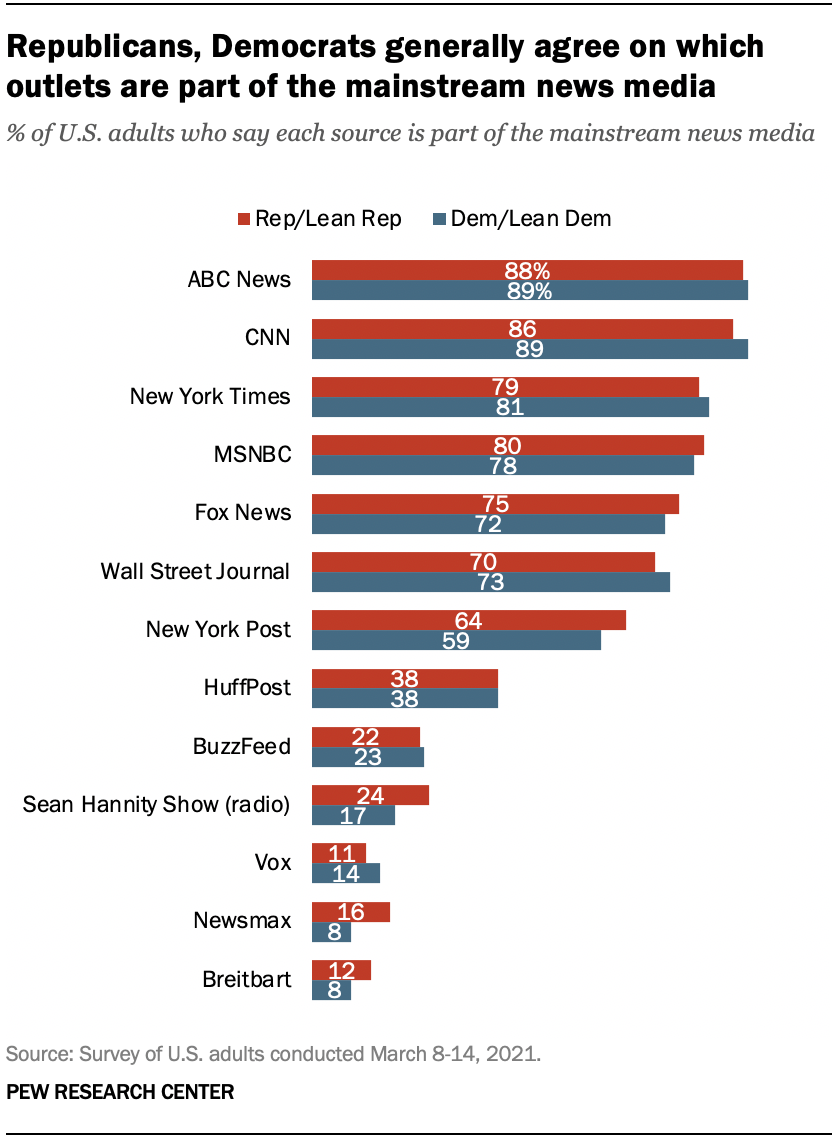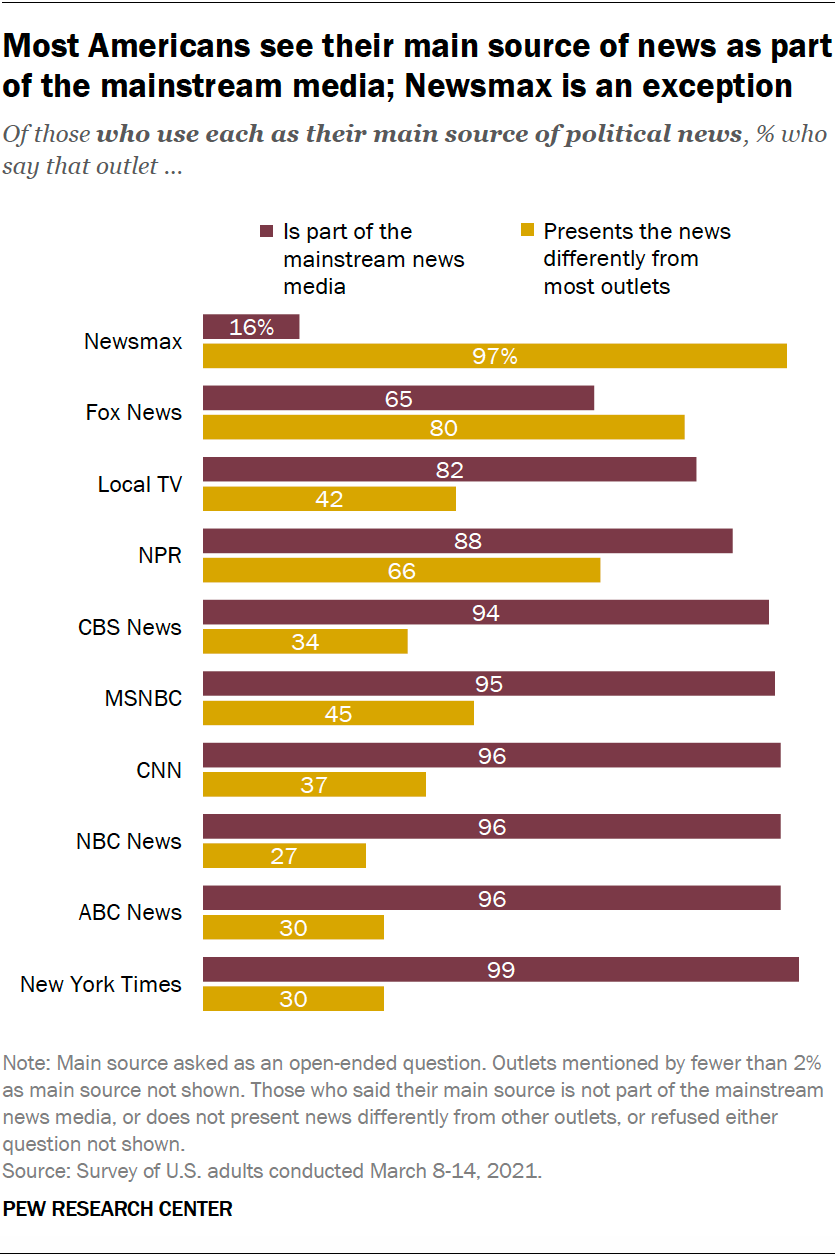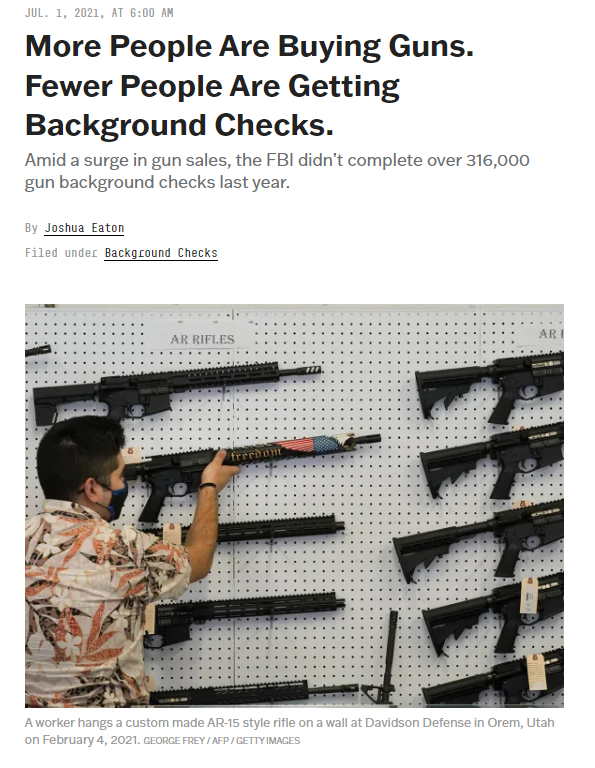
FiveThirtyEight is a political blog that began in 2008 and is dedicated to audiences in the United States. It is primarily known for its focus on poll data analysis, however, the blog has had moments in which it discussed other topics. In late 2023, the site refocused on strictly political analysis and streamlined its content directly into ABC News to cut costs.
Regardless of the partisanship of readers, many find ABC News to be a form of mainstream media. It is important to examine the potential bias present in its work, regardless of its widespread appeal. As demonstrated by Pew Research over 85% of both Republicans and Democrats agree that ABC News is mainstream:

This piece seeks to discern the political biases of FiveThirtyEight’s reporting and editing. We hope to provide an extensive analysis that includes the varying components of bias within media.
How Does Biasly Rate News Sources?
Biasly’s algorithms produce bias ratings to help provide multiple perspectives on given articles. Biasly has analyzed 200,000+ news articles from more than 3,200 news sources through our A.I. technology and team of political analysts to find the most factual, unbiased news stories.
Biasly determines the degree of political bias in news sources by using Biasly’s Bias Meter Rating, in which Biasly’s team analyzes media sources’ reliability and bias and produces three scores, a Reliability Score that measures the accuracy of media sources; an A.I. Bias Score, evaluated by A.I.; and an Analyst Bias Score evaluated by political analysts. These scores are rated based on seven metrics: Tone, Tendency, Diction, Author Check, Selection/Omission, Expediency Bias, and Accuracy. These metrics help our analysts to determine the political attitude of the article.
Our A.I. machine-learning system employs natural language processing and entity-specific sentiment analysis to examine individual articles and determine their bias levels. By analyzing the key terms in an article such as policies, bias phrases, political terminologies, politicians, and their nicknames, the algorithms can rate the attitude of the text. Bias scores range from -100% and 100%, with higher negative scores being more liberal higher positive scores being more conservative, and 0% being neutral.
Is FiveThirtyEight Politically Biased?
The scores at Biasly are determined by both media analyst and AI scores. In the case of FiveThirtyEight, the Analyst Bias Score of Somewhat Liberal, and the Computer Bias Score of Moderately Liberal. These scores are based on the reviews of 15 articles, each article with a Republican, Liberal, and moderate analyst. As more articles are reviewed, the more accurate the score becomes. In this case, the results indicate FiveThirtyEight generally has a liberal bias, most apparent in its negative portrayal of republican figures and at times favoring liberal policies on topics such as border control, criminal justice, and gun control.
In a recent post on X, FiveThirtyEight promoted their article, “No one is going to save us from Trump vs. Biden 2.0.” The article is Somewhat Liberal, rated by our AI system, meaning it is relatively central. The comments reflect this generally central audience, with different reactions including:
“We know”
“No one needs to be saved from Trump v. Biden. We have a crystal clear choice of saving our democracy or not. You’ve gone from attempting to objectively understand polling to subjectively pushing a message. Perhaps 538 has #JumpedTheShark”
“Who’s going to save us from 538’s bitter nonsense.”
we know
— Chris Staiti (@realStaiti) March 23, 2024
No one needs to be save from Trump v. Biden. We have a crystal clear choice of saving our democracy or not. You’ve gone from attempting to objectively understand polling to subjectively pushing a message. Perhaps 538 has #JumpedTheShark
— Robert Hall (@RAH335) March 21, 2024
Who’s going to save us from 538’s bitter nonsense?
— Liberal Beers ☮️ (@MilesDestin) March 21, 2024
While some comments are critical and others agree, the range of perspectives of the community commenting on 538’s article demonstrates its general, but liberal-leaning audience. Readers, in turn, may be influenced by 538’s liberal-leaning bias depending on their personal politics. It is important to remember that even a slight bias does have a bearing on the content and reaction to it. Recognizing bias is an important skill in today’s media landscape, a skill we will discuss in the remainder of this article.
Before we begin, we need to discuss bias. Bias is a natural function of humans, and we can express it both consciously and unconsciously. Bias is one of the most fundamental forms of pattern recognition in humans. This isn’t to lower the bar and say that “all things are biased,” but to explain the process in which we may come to trust certain news organizations that display patterns of coverage.
On the media’s part, there is an incentive to retain audiences, encourage them to purchase subscriptions, and rate products positively. Bias is a two-way street, people want to see news stories about things they care about, and the media needs viewers to continue their operations. This creates a positive feedback loop that influences what stories are covered and from what perspective. This also explains the actions of more liberal news organizations.
Analysis of Bias in FiveThirtyEight Online Articles
The reach ABC News, and by extension FiveThirtyEight, is further presented in an extended study by Pew Research. They found that ABC News was among the preferred sources with more generalized information with a reflection of 96% of audiences finding it a mainstream source with only 30% finding its presentation to be unique. This is more telling when compared to other sources that are generally more heavily biased and have a lower percentage of audiences agreeing they fall within mainstream media and a higher percentage finding they present information differently.

Upon analysis of bias, our analysts consider five main metrics; Tone, Tendency, Author, Diction, and Expediency Bias. Each metric is defined below:
- Tone: A way to phrase the authors’ writing attitudes, distinctive of, but adjacent to word choice and diction.
- Diction: The vocabulary of the author.
- Author: The political track record of the writers’ previous articles and media presence.
- Tendency: The consistency of the authors’ preferred tone or perspective.
- Expediency Bias: Initial impression of the article based on visual and summary elements of the article.
The article in question is titled “More People are Buying Guns. Fewer People Are Getting Background Checks.” Immediately upon viewing the article, the reader knows what the topic of discussion will be. It is an article representative of FiveThirtyEight’s general story, an analysis of metrics within the United States. The author’s tone in favor of gun control is visible, largely visible in the imagery that portrays AR-15s. This particular image is tied with the heading of gun purchases, establishing an image in the readers’ minds of larger weapons throughout the article.

Source: FiveThirtyEight
The tonality of the article is Somewhat Liberal, reflected in the author’s introductory paragraph. While he focuses on objective information, the introduction presents his views that the current gun control system is insufficient. This is heightened by his appeal to fear, correlating firearm sales with the surge in violent crime.
“America’s gun background check system, designed to keep weapons out of the hands of people who might use them in crimes, has struggled to keep up with record firearms sales over the past year — even as violent crime has risen dramatically in many U.S. cities.”
His language is written to support and uphold gun control laws, insinuating that the system has been inefficient. While it does not vilify gun ownership, nor any particular political party, it is fairly consistent throughout to show support towards stricter gun control laws associated with liberalism. This is most evident in the tonality of the sub-headings, framing the mostly objective information in a subjective light, including:
“From bad to worse”
“A growing problem”
“Few answers and fewer solutions.”
In contrast to the tone, the diction is mostly neutral throughout the story. His vocabulary is never overtly liberal or republican, but rather matter-of-fact. Consider his references to both the democratic and republican sources:
“The National Shooting Sports Foundation, which represents the firearms industry, has worked to get more state and local records — especially ones related to mental health — into the background check system in order to cut down on delays.”
“others, like Connecticut Sen. Richard Blumenthal, think Congress needs to change the law so dealers can’t sell a gun without a completed background check.
The Democratic congressman has sponsored a bill, S. 591, that would require a completed background check for a gun sale.”
“it’s not clear what the solution is. Gun-control advocates would like to see the law changed so dealers can’t sell guns until a background check is complete. Opponents say that even with all the time in the world, the FBI can’t complete background checks if it doesn’t get the right records”
When referring to the issues at hand and mentioning the advocates for different sides of the argument, Eaton remains neutrally-balanced. His personal biases could not be assumed from these passages alone, and in turn, the article becomes more informative for the reader. The evidence and persons mentioned are objectively presented, simply addressing the numbers associated with gun ownership and completion of background checks. For example, when referring to proponents of either party, he uses neutral terms such as “gun-control advocates” and “opponents”.
Joshua Eaton, the author, does lean toward liberalism within his own X feed. While the majority of his media content is related to his work as an investigative journalist and education. He has the occasional tweet that is critical of conservatives, for example, he reposted Jack Jenkins’ tweet that stated:
“I’ve noted this before, but can’t stress it enough: My first feature as a journalist was covering work Catholic Charities did with migrants at the border in 2014. Ted Cruz and Glenn Beck were there *celebrating* that work. The shift among some conservatives since has been huge.”
I’ve noted this before, but can’t stress it enough: My first feature as a journalist was covering work Catholic Charities did with migrants at the border in 2014.
Ted Cruz and Glenn Beck were there *celebrating* that work.
The shift among some conservatives since has been huge. https://t.co/kXDWfS1ZP8
— Jack Jenkins (@jackmjenkins) March 23, 2024
However, these comments are limited, as the majority of his content is more moderate. While this tweet has no direct commentary tied to gun control, it demonstrates his liberal tendencies.
Overall, the article is “Somewhat Liberal,” remaining largely as an objective analysis of data received directly from the FBI regarding background checks and gun purchases. While it does promote liberal ideas surrounding gun control throughout its framing, the diction enables the information to remain moderate. This aligns with the author’s perspectives as he shows signs of liberalism in his social feeds.
Many articles at FiveThirtyEight are similar in the fact they tend to focus on objective analysis of statistical data. At times, similar to Eaton, some authors may discuss a liberal subject matter, but they are discussed with objectivity founded on data.
Analysis of FiveThirtyEight Opinion Articles
FiveThirtyEight does not publish articles labeled as opinion articles. While they do have podcasts, even their podcasts are focused on analyzing poll data rather than discussing subjective opinions. Some of the polls may focus on an issue that is Republican or Democratic, but each focuses on objective reporting of the polls that occur. An example of an article that appears more partisan than others is Neil Lewis Jr.’s publication titled, “Why Many Americans Can’t See The Wealth Gap Between White And Black America.”
By the title alone, it is clear the author is promoting liberal ideas regarding race in America. Throughout the article, he promotes liberal ideas about race, for example, he writes,
“The reality is that our nation is still racially segregated. And it’s segregated in ways that limit our opportunities to learn about each other’s life experiences.”
While his claims are backed with objective evidence, it is employed to promote liberal ideology without addressing counter-arguments or differing perspectives.
Other partisan articles similarly present objective facts with subjective interpretations. Subjectivity is not always present in what is presented, but more often what isn’t. True objectivity, or truly neutral political reporting, is nearly impossible. Bias is implicit when individuals are subject to different environments and perspectives. It becomes more explicit in the endorsement of ideas primarily promoted by one side, rather than promoting and addressing counter-arguments from alternate perspectives.
Who Owns FiveThirtyEight?
Although founded by Nate Silver, a self-described, “centrist on economic policy, but liberal or libertarian on social policy.” The source is owned and operated by ABC News, which is an arm of the publicly owned Walt Disney Company. Silver parted ways with FiveThirtyEight on April 2023, but ABC News is also found to be liberal by Biasly. The current president of ABC News is Kimberly Godwin. Her political stance is publically liberal, given the content of ABC News and its general biases, as well as her public statements regarding Donald Trump. Her influence has been more brief on FiveThirtyEight as she became president in April 2021. Regardless, the history of both Kimberly Godwin and ABC News suggests a continued liberal bias for FiveThirtyEight in the future.

Kimberly Godwin
Source: Wikipedia

Nate Silver
Source: Wikipedia
How to Evaluate and Uncover Bias
It can often be difficult to tell if the news you watch is biased. If you have settled on a news channel, it’s usually because you trust the information you are gaining. Unfortunately, many trust the information they are hearing because it confirms what they already believe. This is referred to as “confirmation bias.” It is important to challenge your beliefs and get third-party verification that what you are hearing is the full story. This is why we recommend using Biasly to compare different news stories side-by-side using our bias ratings to figure out what both sides think of a political issue.
While Biasly analysts found FiveThirtyEight to be “Somewhat Liberal” some of their pieces lean further to the left or right than others. Regardless of FiveThirtyEight’s focus on objective analysis of polls, factors such as authorship, ownership, and subjective framework of some topics are critical to be aware of when considering the bias of their articles. Simply put, each article is different and each author is different, some are more factual than others, hence the importance of using Biasly’s News Check regardless of the supposed objectivity.























